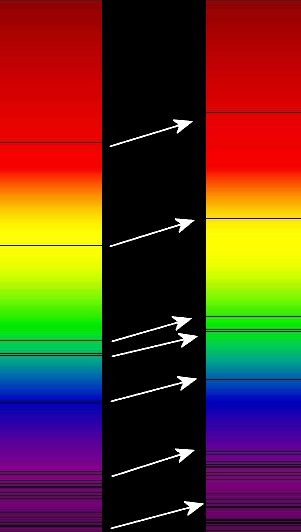EXPLORE: Redshift & Blueshift (BrainPop)
This book will describe redshift & blueshift. Redshift is one of the pieces of evidence used to support the Big Bang theory.
3. Redshift & Blueshift
If you look at a star through a prism, you will see a spectrum, or a range of colors through the rainbow. This is just one piece of the electromagnetic spectrum, but changes in this spectrum are one of the key pieces of evidence to support the Big Bang Theory.
When astronomers started to study the spectrum of light from distant galaxies, they noticed something strange. The dark lines in the spectrum were in the patterns they expected, but they were shifted toward the red end of the spectrum, as shown in the picture below. This shift of absorption bands toward the red end of the spectrum is known as redshift.
Redshift is a shift in absorption bands toward the red end of the spectrum. Redshift occurs when the light source is moving away from you or when the space between you and the source is stretched.
Redshift occurs when the source of light is moving away from the observer. So when astronomers see redshift in the light from a galaxy, they know that the galaxy is moving away from Earth. The strange part is that almost every galaxy in the universe has a redshift, which means that almost every galaxy is moving away from us. This is one piece of evidence astronomers use to support the Big Bang theory because it proves the universe is expanding.
Blueshift is the opposite of redshift. As an object moves towards an observer, the wavelength decreases and light is shifted towards the blue end of the electromagnetic spectrum.
The following video explains redshift and blueshift:
Source
David Bethel
http://ck12.org/flexr/assemble/?fid=732 (CC BY-SA)

